中国血液透析临床实践指南2015
- 格式:pdf
- 大小:481.32 KB
- 文档页数:6
![血液透析充分性临床实践指南[1]](https://uimg.taocdn.com/d2d0cc43a5e9856a57126051.webp)
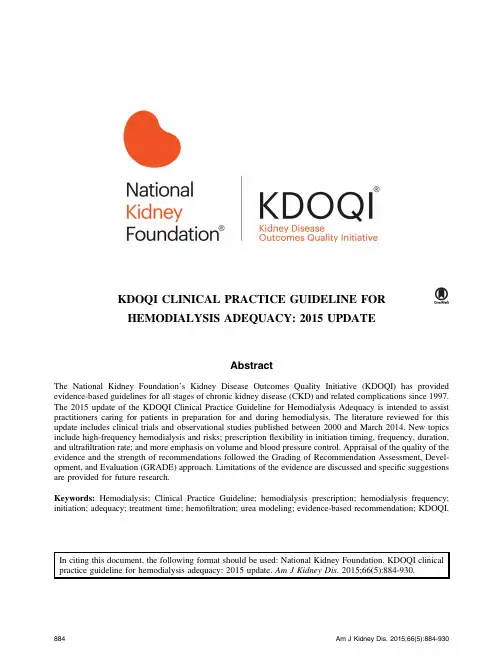
KDOQI CLINICAL PRACTICE GUIDELINE FORHEMODIALYSIS ADEQUACY:2015UPDATEAbstractThe National Kidney Foundation’s Kidney Disease Outcomes Quality Initiative(KDOQI)has provided evidence-based guidelines for all stages of chronic kidney disease(CKD)and related complications since1997. The2015update of the KDOQI Clinical Practice Guideline for Hemodialysis Adequacy is intended to assist practitioners caring for patients in preparation for and during hemodialysis.The literature reviewed for this update includes clinical trials and observational studies published between2000and March2014.New topics include high-frequency hemodialysis and risks;prescriptionflexibility in initiation timing,frequency,duration, and ultrafiltration rate;and more emphasis on volume and blood pressure control.Appraisal of the quality of the evidence and the strength of recommendations followed the Grading of Recommendation Assessment,Devel-opment,and Evaluation(GRADE)approach.Limitations of the evidence are discussed and specific suggestions are provided for future research.Keywords:Hemodialysis;Clinical Practice Guideline;hemodialysis prescription;hemodialysis frequency;initiation;adequacy;treatment time;hemofiltration;urea modeling;evidence-based recommendation;KDOQI.884Am J Kidney Dis.2015;66(5):884-930Work Group Membership Work Group ChairsJohn T.Daugirdas,MD University of Illinois College of MedicineChicago,ILThomas A.Depner,MD University of California,Davis Sacramento,CAWork Group MembersJula Inrig,MD,MHSDuke University Medical CenterYorba Linda,CARajnish Mehrotra,MDUniversity of WashingtonDivision of Nephrology,Harborview Medical CenterSeattle,WAMichael V.Rocco,MD,MSCEWake Forest School of MedicineWinston Salem,NCRita S.Suri,MD,MSc,FRCPCUniversity of MontrealMontreal,QuebecDaniel E.Weiner,MD,MSTufts Medical CenterBoston,MAEvidence Review TeamUniversity of Minnesota Department of MedicineMinneapolis VA Center for Chronic Disease Outcomes Research,Minneapolis,MN,USANancy Greer,PhD,Health Science SpecialistAreef Ishani,MD,MS,Chief,Section of Nephrology,Associate Professor of MedicineRoderick MacDonald,MS,Senior Research AssistantCarin Olson,MD,MS,Medical Editor and WriterIndulis Rutks,BS,Trials Search Coordinator and Research AssistantYelena Slinin,MD,MS,Assistant Professor of MedicineTimothy J.Wilt,MD,MPH,Professor of Medicine and Project DirectorAm J Kidney Dis.2015;66(5):884-930885KDOQI LeadershipMichael Rocco,MD,MSCEKDOQI ChairHolly Kramer,MDVice Chair,ResearchMichael J.Choi,MDVice Chair,EducationMilagros Samaniego-Picota,MDVice Chair,PolicyPaul J.Scheel,MD,MBAVice Chair,PolicyKDOQI Guideline Development StaffKerry Willis,PhD,Chief Scientific OfficerJessica Joseph,MBA,Vice President,Scientific ActivitiesLaura Brereton,MSc,KDOQI Project Director886Am J Kidney Dis.2015;66(5):884-930NOTICESECTION I:USE OF THE CLINICAL PRACTICE GUIDELINEThis Clinical Practice Guideline document is based upon the best information available as of June2015.It is designed to provide information and assist decision making.It is not intended to define a standard of care,and should not be construed as one,nor should it be interpreted as prescribing an exclusive course of management. Variations in practice will inevitably and appropriately occur when clinicians take into account the needs of individual patients,available resources,and limitations unique to an institution or type of practice.Every health care professional making use of these recommendations is responsible for evaluating the appropriateness of applying them in the setting of any particular clinical situation.The recommendations for research contained within this document are general and do not imply a specific protocol.SECTION II:DISCLOSUREKidney Disease Outcomes Quality Initiative(KDOQI)makes every effort to avoid any actual or reasonably perceived conflicts of interest that may arise as a result of an outside relationship or a personal,professional,or business interest of a member of the Work Group.All members of the Work Group are required to complete, sign,and submit a disclosure and attestation form showing all such relationships that might be perceived or actual conflicts of interest.This document is updated annually and information is adjusted accordingly.All reported information is onfile at the National Kidney Foundation(NKF).Am J Kidney Dis.2015;66(5):884-930887Table of ContentsContents Figures (889)Abbreviations and Acronyms (890)Current CKD Nomenclature Used by KDOQI (891)Executive Summary (892)Gathering the Evidence (892)Initiating HD (892)Frequency and Duration of Dialysis (892)Membranes and Hemodiafiltration Versus HD (893)Small-Solute Clearance (893)Adverse Effects of Dialysis (893)Limitations of“Adequacy” (893)Structure of the Work Group (893)Methods (893)ERT Study Selection and Outcomes of Interest (894)Guideline Statements (895)Guideline1:Timing of Hemodialysis Initiation (896)Rationale for Guideline1.1 (896)Research Recommendations (897)Rationale for Guideline1.2 (897)Guideline2:Frequent and Long Duration Hemodialysis (902)Background and Definitions (902)Evidence Overview (902)Rationale for Guidelines2.1and2.2 (903)Research Recommendations (905)Rationale for Guidelines2.3and2.4 (905)Research Recommendations (907)Rationale for Recommendation2.5 (907)Research Recommendations (907)Guideline3:Measurement of Dialysis—Urea Kinetics (908)Rationale (908)Target Dose(Guideline3.1) (908)Adjustments for Kru(Guideline3.2) (909)HD Schedules Other Than Thrice Weekly(Guideline3.3) (910)Limitations of the Guidelines (910)Research Recommendations (911)Appendix to Guideline3 (911)Guideline4:Volume and Blood Pressure Control—Treatment Time And Ultrafiltration Rate (913)Rationale for Guideline4.1 (913)Rationale for Guideline4.2 (914)Research Recommendations (916)Guideline5:Hemodialysis Membranes (917)Rationale (917)Hemodiafiltration (918)Research Recommendations (918)Acknowledgements (919)Biographic and Disclosure Information (920)References (924)888Am J Kidney Dis.2015;66(5):884-930TablesTable1.Grade for Strength of Recommendation (895)Table2.Summary Data From Observational Studies That Assessed the Association Between Serum Creatinine–Based Estimates of Kidney Function at the Time of Initiation of Dialysis andRisk for Death (899)Table3.Summary Data From Observational Studies That Assessed the Association Between Measured Kidney Function at the Time of Initiation of Dialysis and Risk for Death (900)monly Used Validated GFR Estimating Equations in Adults (900)Table5.Clinical Settings Affecting Creatinine Generation (901)Table6.Descriptive Nomenclature for Various HD Prescriptions (903)Table7.Summary:Randomized Trials of More Frequent HD (904)Table8.Published Clinical Studies on the Effect of Lowering Dialysate Sodium onSubsequent BP (915)FiguresFigure1.Systematic errors from2commonly used linear formulas based on percent reduction in urea concentration (909)Figure2.Data from the Netherlands Cooperative Study showing a marked increase in risk of death in patients with no residual native kidney function (910)Figure3.Delivered dialysis doses in the HEMO Study (912)Am J Kidney Dis.2015;66(5):884-930889Abbreviations and AcronymsACTIVE Advanced Cognitive Training for Independent and Vital ElderlyAV ArteriovenousavCpre Average predialysis blood urea nitrogenBP Blood pressureBSA Body surface areaBUN Blood urea nitrogenCANUSA Canadian-USA Study on Adequacy of Peritoneal DialysisCI Confidence intervalCi Dialysate inlet conductivitiesCKD Chronic kidney diseaseCKD-EPI Chronic Kidney Disease Epidemiology CollaborationCL cr Creatinine clearanceCo Dialysate outlet conductivitiesCV CardiovascularD DialysanceDRIP Dry Weight Reduction InterventionECV Extracellular volumeeGFR Estimated glomerularfiltration rateeKt/V Equilibrated Kt/VERT Evidence Review TeamESA Erythropoiesis-stimulating agentESHOL Estudio de Supervivencia de Hemodiafiltración On-LineESRD End-stage renal diseaseFHN Frequent Hemodialysis NetworkG Urea generationGFAC G-factorGFR Glomerularfiltration rateGRADE Grading of Recommendations Assessment,Development,and Evaluation HD HemodialysisHEMO NIH study of HD dose and membranefluxHR Hazard ratioIDEAL Initiating Dialysis Early and LateKDIGO Kidney Disease:Improving Global OutcomesKDOQI Kidney Disease Outcomes Quality InitiativeKru Residual kidney functionKRT Kidney replacement therapyLVH Left ventricular hypertrophyMDRD Modification of Diet in Renal DiseasemGFR Measured glomerularfiltration rateMPO Membrane Permeability OutcomeNa SodiumNCDS National Cooperative Dialysis StudyNECOSAD Netherlands Cooperative Study on the Adequacy of DialysisNIH National Institutes of HealthNKF National Kidney FoundationNS Not specifiedPCR Protein catabolic ratePD Peritoneal dialysisPIDI Preceding interdialysis intervalPru Percent reduction in urea concentrationQb Bloodflow rateQd Dialysateflow rateQf UltrafiltrationflowR Ratio of postdialysis to predialysis BUNRAAS Renin-angiotensin-aldosterone systemRCT Randomized controlled trialRR Relative riskSA-sdtKt/V Surface area–adjusted standard Kt/VScr Serum creatinineScys Serum cystatin Csp Single-pool(Kt/V)std Standard(Kt/V)T Treatment time in hoursTiME Time to Reduce Mortality in End-Stage Renal Disease trialUf Ultrafiltration rateURR Urea reduction ratioUSRDS US Renal Data SystemV Urea volume890Am J Kidney Dis.2015;66(5):884-930Current CKD Nomenclature Used by KDOQICKD Categories DefinitionCKD CKD of any stage(1-5),with or without a kidney transplant,including bothnon–dialysis-dependent CKD(CKD1-5ND)and dialysis-dependent CKD(CKD5D)CKD ND Non–dialysis-dependent CKD of any stage(1-5),with or without a kidneytransplant(ie,CKD excluding CKD5D)CKD T Non–dialysis-dependent CKD of any stage(1-5)with a kidney transplantSpecific CKD StagesCKD1,2,3,4Specific stages of CKD,CKD ND,or CKD TCKD3-4,etc Range of specific stages(eg,both CKD3and CKD4)CKD5D Dialysis-dependent CKD5CKD5HD Hemodialysis-dependent CKD5CKD5PD Peritoneal dialysis–dependent CKD5Am J Kidney Dis.2015;66(5):884-930891Executive SummaryWhen hemodialysis(HD)was introduced as an effective workable treatment in1943,1the outlook for patients with advancing kidney failure suddenly changed from anticipation of impending death to in-definite survival.Since then,implementation of dia-lysis has advanced from an intensive bedside therapy to a more streamlined treatment,sometimes self-administered in the patient’s home,using modern technology that has simplified dialysis treatment by reducing the time and effort required by the patient and caregivers.Standards have been established to efficiently care for large numbers of patients with a balance of resources and patient time.However, simplified standards can lead to inadequate treatment, so guidelines have been developed to assure patients, caregivers,andfinancial providers that reversal of the uremic state is the best that can be offered and com-plications are minimized.The National Kidney Foundation(NKF)continues to sponsor this forum for collaborative decision making regarding the aspects of HD that are considered vital to achieve these goals. Over400,000patients are currently treated with HD in the United States,with Medicare spending approaching$90,000per patient per year of care in 2012.2Unfortunately,although mortality rates are improving(30%decline since1999),they remain several-fold higher than those of age-matched in-dividuals in the general population,and patients experience an average of nearly2hospital admissions per year.3Interventions that can improve outcomes in dialysis are urgently needed.Attempts to improve outcomes have included initiating dialysis at higher glomerularfiltration rates(GFRs),increasing dialysis frequency and/or duration,using newer membranes, and employing supplemental or alternative hemofil-tration.Efforts to increase the dose of dialysis admin-istered3times weekly have not improved survival, indicating that something else needs to be addressed.GATHERING THE EVIDENCEThe literature reviewed for this adequacy update includes observational studies and clinical trials published from2000to2014.In some cases,high-quality data have been presented to support conclu-sions,but in most cases,clinicians are left with incomplete or inadequate data.In these situations,as in many aspects of general medical care,decisions about treatments must be based on logic and obser-vation.A major goal of the Work Group and Evi-dence Review Team(ERT)was to compile and evaluate as much information as possible to arrive at a reasonable answer to the questions posed in Box1,not all of which can be answered definitively with support from controlled clinical trials.Initiating HDDespite lack of evidence from randomized controlled trials(RCTs)about the optimal time to start kidney replacement therapy(KRT),there has been a trend,which has leveled off since2010,in the United States toward earlier initiation of dialysis at higher levels of kidney function.2,3If earlier dialysis is inef-fective,this trend would lead to greater resource utili-zation without clinical benefit.Published in2010, results of the IDEAL(Initiating Dialysis Early and Late)trial explored this issue,and data from this trial constitute the best evidence regarding timing of dialysis initiation,motivating the update of this guideline.4 Frequency and Duration of Dialysis Observational and controlled nonrandomized studies had suggested that more frequent and/or longer dialysis improves the patient’s quality of life,controls hyperphosphatemia,reduces hypertension,and results in regression of left ventricular hypertrophy(LVH).5,6 Abbreviation:CKD,chronic kidney disease.KDOQI HD Adequacy Guideline:2015Update892Am J Kidney Dis.2015;66(5):884-930Based on thesefindings,more frequent and longerdialysis sessions have become more common.Since theprevious KDOQI(Kidney Disease Outcomes QualityInitiative)update,7several RCTs that compared morefrequent or extended dialysis to conventional dialysis have been completed.8-11This update reviews thisevidence.Membranes and Hemodiafiltration Versus HD Cardiovascular(CV)disease is the leading cause ofdeath in patients with CKD stage5,2with uremic toxinsand the kidney failure milieu including volume expan-sion likely important contributing pared tolow-flux dialysis,high-flux dialysis and convectivetherapies such as hemofiltration and hemodiafiltrationprovide higher clearance of larger solutes,removal ofwhich might improve CV outcomes.This update re-views the evidence for use of high-flux compared tolow-flux dialyzer membranes,as well as convectivemodes of KRT compared to conventional HD.Small-Solute ClearanceThis update addresses only the dialysis treatmentwhile acknowledging that there are limits to what dial-ysis can accomplish.Assessment of dialysis requiresmeasurement of the dialysis dose.Included herein arethe current recommended methods for measuring whatdialysis does best,the purging of small dialyzable sol-utes,with the assumption that this function is the essence of the life-prolonging effect of dialysis.How-ever,while optimization of small-solute removal shouldbe considered thefirst priority,assessment of dialysisadequacy should not stop there as the absence of nativekidneys entails loss of many vital functions,only one ofwhich is small-solute removal.Adverse Effects of DialysisEarly investigators postulated that exposure of theblood to a large foreign surface for several hours wouldcause an inflammatory response in the patient anddeplete vital constituents of the blood,such as platelets and clotting factors.Removal of low-molecular-weighthormones,vitamins,and other vital molecules wasalso a concern.Membranes were developed to be “biocompatible,”causing less interaction with blood constituents.While the postulated depletion syndromesapparently never materialized,in recent years,concernhas been raised about transient intra-and postdialysisalkalosis and dialysis-associated reductions in blood pressure(BP),serum potassium,and serum phosphorus and changes in other electrolytes and proteins that may amount to a“perfect storm”of stress potentially responsible for acute cardiac events,as well as long-term effects on the brain and CV system.12-14More frequent and more prolonged dialysis,while improving solute clearance and volume removal,could enhance blood-membrane interaction,add to the burden on pa-tients and caregivers,15and even accelerate loss of native kidney function and vascular access dam-age.16,17The current guideline update includes a listing and recommendations regarding potential benefits and adverse effects associated with more frequent dialysis. Limitations of“Adequacy”The ultimate goal of treatment for patients with CKD stage5is improvement in quality of life,with prolon-gation of life often an additional goal.This requires more than the dialysis treatment itself.In recent liter-ature,adequacy of dialysis is sometimes confused with adequacy of other aspects of patient management,with the erroneous assumption that having achieved dialysis adequacy,the goal of dialysis has been accomplished. In the opinion of the Work Group,this is incorrect:it is important to distinguish adequacy of the dialysis from adequacy of patient care.Dialysis-dependent patients require a number of treatments independent of or only partially dependent on the dialysis itself,many of which were implemented long before the patient’s dialysis started.Guidelines for some of these are addressed in other publications by KDOQI,including management of anemia,nutrition,metabolic bone disease,diabetes,and CV disease.18-22STRUCTURE OF THE WORK GROUPThe volunteer members of the Work Group were selected for their clinical experience,as well as experience with clinical trials and familiarity with the literature,especially regarding the issues surrounding dialysis adequacy.All are practicing nephrologists who have many years of experience with care of pa-tients dependent on KRT.METHODSIn consultation with the KDOQI Hemodialysis Ad-equacy Clinical Practice Guidelines Update Work Group,the Minnesota ERT developed and followed a standard protocol for all steps of the review process. The guideline update effort was a multidisciplinary undertaking that included input from NKF scientific staff,the ERT from the Center for Chronic Disease Outcomes Research at the Minneapolis Veterans Af-fairs Medical Center,and the Work Group.The comprehensivefindings from the systematic literature review prepared for this update are presented in detail in the accompanying article from Slinin et al.23Briefly, MEDLINE(Ovid)was searched from2000to March 2014for English-language studies in populations of all ages.Additional searches included reference lists of recent systematic reviews and studies eligible for in-clusion to identify relevant studies not identified inKDOQI HD Adequacy Guideline:2015UpdateAm J Kidney Dis.2015;66(5):884-930893MEDLINE and to identify any recently completed studies.ERT Study Selection and Outcomes of Interest Studies were included if they were randomized or controlled clinical trials in people treated with, initiating,or planning to initiate maintenance HD for CKD.To be included,studies needed to report the effects of an intervention on all-cause mortality,CV mortality,myocardial infarction,stroke,all-cause hospitalization,quality of life,depression or cognitive performance,BP or BP treatment,left ventricular mass, interdialytic weight gain,dry weight,or harms or complications related to vascular access or the process of dialysis.Observational studies considered by the Work Group that were not selected by the evidenceKDOQI HD Adequacy Guideline:2015Updateteam and are not included in the Evidence Report by the ERT include those evaluating mortality,hard out-comes,and pregnancy-related outcomes with frequent dialysis.For frequency and duration of HD sessions,trials that assigned individuals to more frequent HD (.3times a week)or longer (.4.5hours)dialysis versus conventional HD were included.For studies that compared high-flux to low-flux dialysis membranes or hemo filtration or hemodia filtration to conventional HD,the ERT included trials that enrolled at least 50participants with a minimum of 12months ’follow-up in each treatment arm.GUIDELINE STATEMENTSThe Work Group distilled these answers in the form of 5guidelines,some of which are similar to the pre-vious guidelines published in 20067but have been re-emphasized or reinterpreted in light of new data (Box 2).For each of the guidelines,the quality of the evidence and the strength of the recommendations were graded separately using the Grading of Recommenda-tions Assessment,Development,and Evaluation (GRADE)approach criteria 24:scales of A to D for quality of the evidence and 1or 2for strength of the recommendation,including its potential clinical impact (Table 1;Box 3).The guideline statements were based on a consensus within the Work Group that the strengthof the evidence was suf ficient to make de finitive statements about appropriate clinical practice.When the strength of the evidence was not suf ficient to make such statements,the Work Group offered recommen-dations based on the best available evidence and expert opinion.In cases in which controversy exists but data are sparse,the guideline is ungraded,based on consensus opinion of the Work Group.For a few of the guidelines,not all of the Work Group members agreed,and in such cases,the reasons for disagreement are spelled out in the rationale that follows the guideline statement.For all guidelines,clinicians should be aware that circumstances may appear that would require straying from the recommendations of the WorkGroup.Table 1.Grade for Strength of RecommendationImplicationsBased on Uhlig et al.24aThe additional category “Not Graded”was used,typically to provide guidance based on common sense or where the topic does not allow adequate application of evidence.The most common examples include recommendations regarding monitoring intervals,counseling,and referral to other clinical specialists.The ungraded recommendations are generally written as simple declarative statements,but are not meant to be interpreted as being stronger recommendations than Level 1or 2recommendations.KDOQI HD Adequacy Guideline:2015UpdateGuideline1:Timing of Hemodialysis Initiation1.1Patients who reach CKD stage4(GFR,30mL/min/1.73m2),includingthose who have imminent need for mainte-nance dialysis at the time of initial assess-ment,should receive education about kidneyfailure and options for its treatment,including kidney transplantation,PD,HD inthe home or in-center,and conservativetreatment.Patients’family members andcaregivers also should be educated abouttreatment choices for kidney failure.(NotGraded)1.2The decision to initiate maintenance dialysisin patients who choose to do so should bebased primarily upon an assessment of signsand/or symptoms associated with uremia,evidence of protein-energy wasting,and theability to safely manage metabolic abnor-malities and/or volume overload with med-ical therapy rather than on a specific level ofkidney function in the absence of such signsand symptoms.(Not Graded)RATIONALE FOR GUIDELINE1.1 Recent KDIGO(Kidney Disease:Improving Global Outcomes)and prior KDOQI guidelines recommend referral of all individuals with GFR,30mL/min/1.73m2to a nephrologist,stress-ing that timely nephrology referral maximizes the likelihood of adequate planning for KRT to optimize decision making and outcomes.7,25,26While deter-mining the rate of progression and precise timing of referral is beyond the scope of this guideline,the implication is clear—that patients,their families,and caregivers should have ample time to make informed decisions regarding KRT and to implement these decisions successfully.27Multiple dialysis modalities are available for KRT, including modalities performed in the home and mo-dalities in dialysis facilities,none of which is conclu-sively demonstrated to be superior to the others.28,29 Additionally,conservative nondialysis care may be the appropriate decision for many older or more infirm individuals,30while pre-emptive or early trans-plantation may be the best for many other patients.In patients considering maintenance dialysis,it is impor-tant to acknowledge that each KRT modality adds a unique burden of treatment to the already high burden of disease.In this context,patients,their families,and their caregivers are best positioned to determine which tradeoffs they are willing to make,particularly given the lack of definitive evidence for the superiority of one dialysis modality over the other and the possibility that conservative care may be the option that bestfits some individual patients’goals.Morton and colleagues31 recently provided a thematic synthesis of18qualita-tive studies that reported the experience of375patients and87caregivers.They identified4major themes central to treatment choices:confronting mortality (choosing life or death,being a burden,living in limbo), lack of choice(medical decision,lack of information, constraints on resources),gaining knowledge about options(peer influence,timing of information),and weighing alternatives(maintaining lifestyle,family influence,maintaining status quo).However,none of the essential decisions can be made in an informed manner without adequate time for education and contemplation.As illustrated by Morton and colleagues’systematic review,electing conservative therapy rather than dia-lysis or kidney transplantation is an important option for many people with kidney failure.In one study of 584patients with CKD stages4and5,a total of61%of the patients who had started HD regretted this deci-sion,30and when asked why they chose dialysis,52% attributed this decision to their physician.While this study is limited by a homogeneous population,it is apparent that education prior to dialysis regarding treatment options was insufficient in many,and that this led to dissatisfaction with KRT decisions.The limited ability of care providers to predict patient choice was illustrated by a recent study reporting on focus groups and interviews with11nephrologists and29patients older than65years with advanced CKD.32Both pa-tients and nephrologists acknowledged that discussions about prognosis are rare and patients cope most often with their diagnosis through avoidance,while ne-phrologists expressed concern over evoking negative reactions if they challenge this coping strategy.The Work Group recognizes that the experiences reported in this study are not unique to these patients and phy-sicians;accordingly,we stress the need for patient-centered education to begin early;to involve patients, their families,and their caregivers,if possible;and to be continually reinforced in a positive and patient-sensitive manner.27,31Further,given the high preva-lence of cognitive impairment33and delirium34among patients with kidney failure,as well as acknowledged difficulties predicting the rate of progression to kidney failure among patients with advanced CKD,35-38it is imperative that patients’informants and proxy decision makers be involved in this decision-making process. Few clinical trials have evaluated the potential benefits of referral and education prior to the need for dialysis39,40;accordingly,statements made on this KDOQI HD Adequacy Guideline:2015Update。

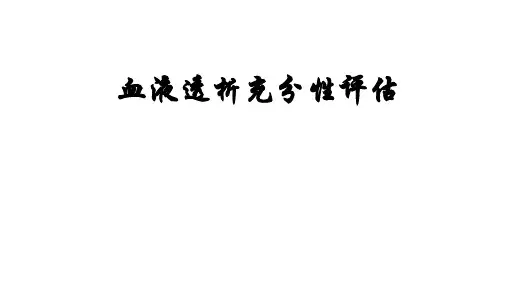
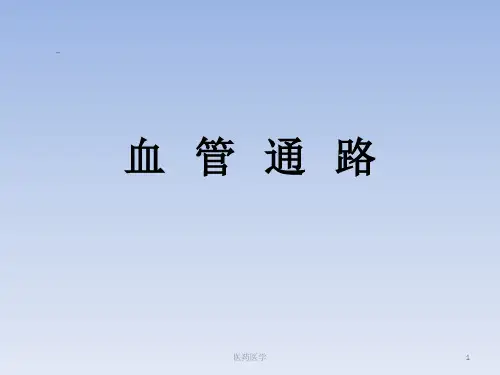
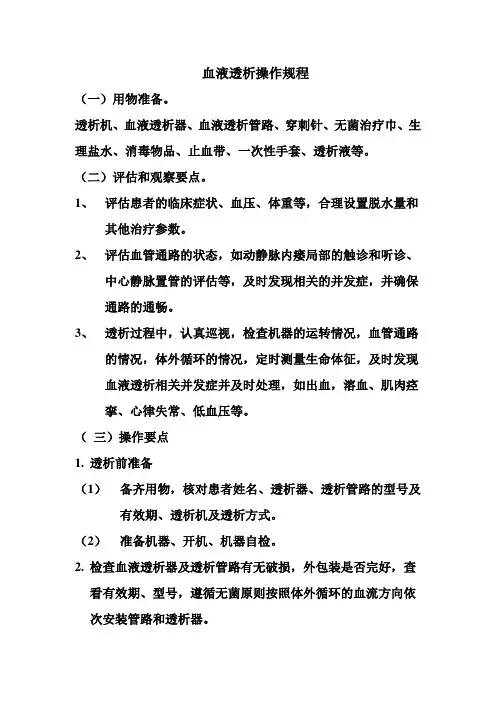
血液透析操作规程(一)用物准备。
透析机、血液透析器、血液透析管路、穿刺针、无菌治疗巾、生理盐水、消毒物品、止血带、一次性手套、透析液等。
(二)评估和观察要点。
1、评估患者的临床症状、血压、体重等,合理设置脱水量和其他治疗参数。
2、评估血管通路的状态,如动静脉内瘘局部的触诊和听诊、中心静脉置管的评估等,及时发现相关的并发症,并确保通路的通畅。
3、透析过程中,认真巡视,检查机器的运转情况,血管通路的情况,体外循环的情况,定时测量生命体征,及时发现血液透析相关并发症并及时处理,如出血,溶血、肌肉痉挛、心律失常、低血压等。
(三)操作要点1.透析前准备(1)备齐用物,核对患者姓名、透析器、透析管路的型号及有效期、透析机及透析方式。
(2)准备机器、开机、机器自检。
2.检查血液透析器及透析管路有无破损,外包装是否完好,查看有效期、型号,遵循无菌原则按照体外循环的血流方向依次安装管路和透析器。
3.预充。
(1)启动透析机血泵80-100ml/min,用生理盐水先排净透析管路和透析血室(膜内)气体,生理盐水流向为动脉端→透析器→静脉端,不得逆流向预冲。
(2)将泵速调至200-300 ml/min,连接透析液接头与透析器旁路,排净透析液室(膜外)气体。
(3)生理盐水预冲量,应严格按照透析器说明书中的要求进行;进行密闭室循环或肝素生理盐水预冲,应在生理盐水预冲量达到500ml后再进行。
(4)预冲生理盐水直接流入废液收集袋中,并将废液收集袋放于机器液架上,不得低于操作者腰部以下。
(5)冲洗完毕后再次核对,根据医嘱设置治疗参数。
4.动静脉内瘘穿刺。
(1)检查患者自身血管通路:有无红肿,渗血,硬结;并摸清血管走向和搏动。
(2)选择好穿刺点,消毒穿刺部位。
(3)根据血管的粗细和血流量要求等选择穿刺针。
(4)采用阶梯式、纽扣式等方法,以合适的角度穿刺血管;先穿刺静脉,再穿刺动脉,以动脉端穿刺点与动静脉内瘘口3cm以上,动静脉穿刺点之间的距离在10cm以上为宜,固定穿刺针。
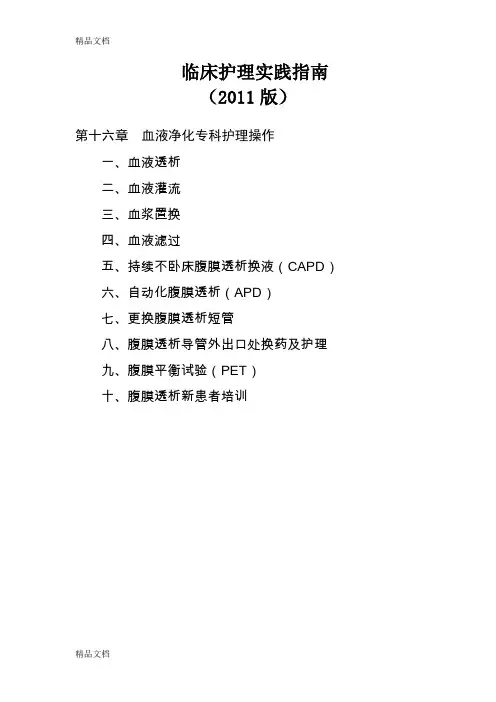
临床护理实践指南(2011版)第十六章血液净化专科护理操作一、血液透析二、血液灌流三、血浆置换四、血液滤过五、持续不卧床腹膜透析换液(CAPD)六、自动化腹膜透析(APD)七、更换腹膜透析短管八、腹膜透析导管外出口处换药及护理九、腹膜平衡试验(PET)十、腹膜透析新患者培训第十六章血液净化专科护理操作自20世纪60年代血液透析操作技术问世以来,血液净化操作技术迅猛发展。
治疗的指征也从单纯的肾脏替代治疗扩展到血液病、风湿病、自身免疫性疾病、药物或毒物中毒、重症肝炎以及危重患者抢救等多个领域。
护士在血液净化治疗中发挥着重要作用。
护士不仅需要掌握规范的操作流程,严格遵循无菌原则,准确、安全、熟练地进行技术操作;同时也需要严密监测患者的生命体征及各项指标的变化,预防和处理并发症;更要为长期透析的患者提供健康指导,促进他们自我管理和康复。
一、血液透析(一)评估和观察要点。
1.评估患者的临床症状、血压、体重等,合理设置脱水量和其他治疗参数。
2.评估血管通路的状态,如动静脉内瘘局部的触诊和听诊,中心静脉置管的评估等,及时发现相关并发症,并确保通路的通畅。
3.透析过程中,认真巡视,检查机器的运转情况,血管通路的情况,体外循坏情况,定时测量生命体征,及时发现血液透析相关并发症并及时处理,如出血、溶血、肌肉痉挛、心律失常、低血压等。
(二)操作要点。
1.透析前准备。
(1)备齐用物,核对患者姓名、透析器、透析管路的型号及有效期、透析机及透析方式。
(2)准备机器,开机,机器自检。
2.检查血液透析器及透析管路有无破损,外包装是否完好,查看有效日期、型号,遵循无菌原则按照体外循环的血流方向依次安装管路和透析器。
3.预冲。
(1)启动透析机血泵80~100ml/min,用生理盐水先排净透析管路和透析器血室(膜内)气体,生理盐水流向为动脉端→透析器→静脉端,不得逆向预冲。
(2)将泵速调至200~300ml/min,连接透析液接头与透析器旁路,排净透析器透析液室(膜外)气体。
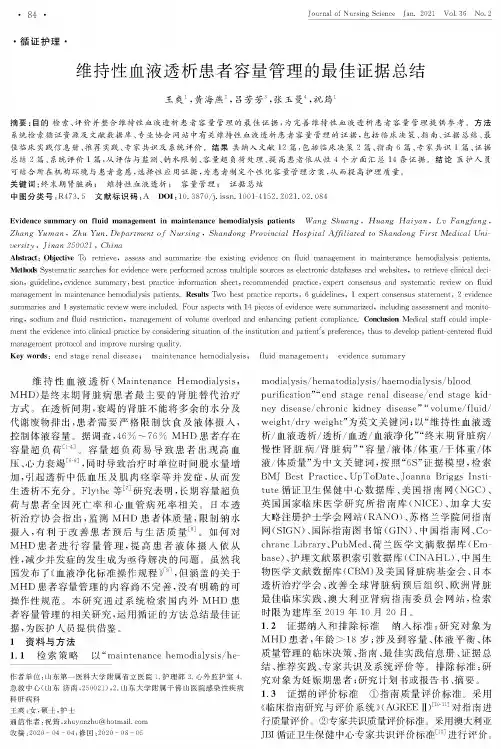
・84・JournalofNursingScience Jan2021Vol.36No.2•循证护理•维持性血液透析患者容量管理的最佳证据总结王爽】,黄海燕2,吕芳芳3,张玉曼4,祝筠1摘要:目的检索、评价并整合维持性血液透析患者容量管理的最佳证据,为完善维持性血液透析患者容量管理提供参考%方法系统检索循证资源及文献数据库、专业协会网站中有关维持性血液透析患者容量管理的证据,包括临床决策、指南、证据总结、最佳临床实践信息册、推荐实践、专家共识及系统评价%结果共纳入文献12篇,包括临床决策2篇、指南6篇、专家共识1篇、证据总结2篇、系统评价1篇,从评估与监测、钠水限制、容量超负荷处理、提高患者依从性4个方面汇总14条证据%结论医护人员可结合所在机构环境与患者意愿,选择性应用证据,为患者制定个性化容量管理方案,从而提高护理质量%关键词:终末期肾脏病;维持性血液透析;容量管理;证据总结中图分类号.R473.5文献标识码:A DOI:10.3870/j.issn.1001-4152.202102.084Evidence summary on fluid management in maintenance hemodialysis patients Wang Shuang$Huang Haiyan$L d Fangfang$ Zhang Yu.an$Zhu Yun.Department of Nursing$Shandong Provincial Hospital Affiliated to Shandong First Medical University$Jinan250021$ChinaAbstract:Objective To retrieve,assess and summarize the existing evidence on fluid management in maintenance hemodialysis patients. Methods Systematic searches for evidence were performed across multiple sources as electronic databases and websites,to retrieve clinical decision,guideline,evidence summary,best practice information sheet,recommended practice,expert consensus and systematic review on fluid management in maintenance hemodialysis patients.Results Two best practice reports,6guidelines,1expert consensus statement,2evidence summaries and1systematic review were included.Four aspects with14pieces of evidence were summarized,including assessment and monitoring,sodium and fluid restriction,management of volume overload and enhancing patient compliance.Conclusion Medical staff could imple-menttheevidenceintoclinicalpracticebyconsideringsituationoftheinstitutionandpatient'spreference thustodeveloppatient-centeredfluid managementprotocolandimprovenursingqualityKey words:end stage renal disease;maintenance hemodialysis;维持性血液透析(Maintenance Hemodialysis, MHD)是终末期肾脏病患者最主要的肾脏替代治疗方式。
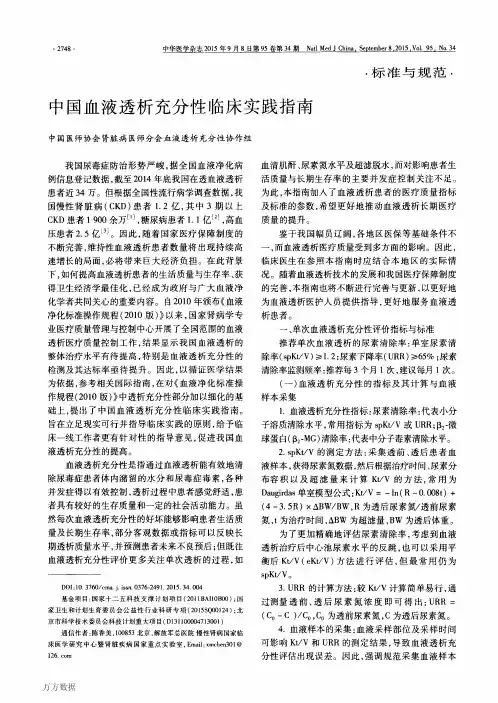
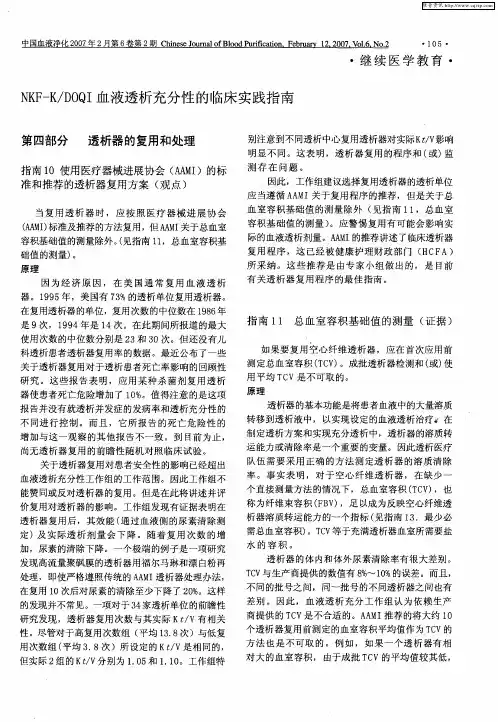
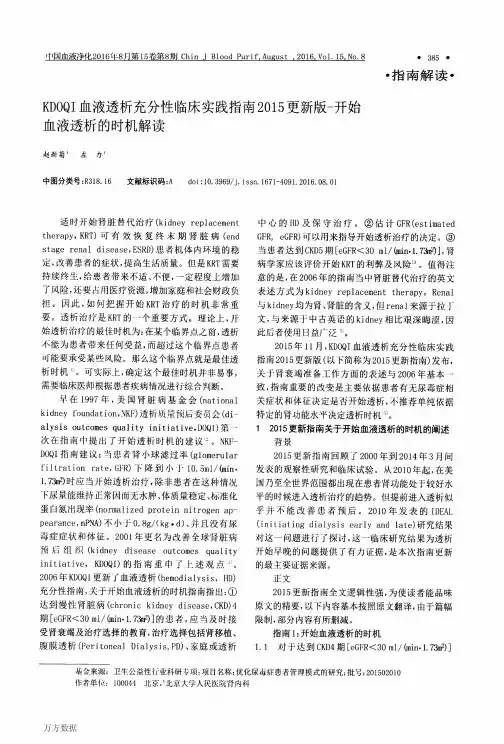
血透患者干体重达标标准及控制方法判断干体重达标标准干体重不是固定不变的,它和正常人的体重一样,是一个变数,随着季节、年龄、饮食、排泄、天气等因素的变化而变化。
判断干体重是否达标,在《中国血液透析充分性临床实践指南》中给出的干体重标准为:(1)透析过程中无明显的低血压;(2)透析前血压得到有效控制;(3)临床无浮肿表现;(4)胸部X线无肺淤血征象;(5)心胸比值:男性<50%,女性<53%;(6)有条件者也可以应用生物电阻抗法进行评估。
干体重不达标的解决方法影响干体重不达标的因素有很多,如透析次数过少、透析时间不足、高盐饮食、水分摄入过多等。
因此想要干体重达标,则需要从透析、护理及饮食等多方面管理。
1、控制体重增长血液透析人群干体重达标,推荐透析间期体重增长率<5%干体重。
即两次透析间隙体重增加幅度不超过干体重(基础体重)的5%。
2、加强透析选择合适的超滤率及血透时间。
二者决定了透析治疗中水的清除量,直接与透析间期体重增长相关。
而保持较低的超滤率对于避免血液透析过程中并发症的发生是有益的。
因此,《中国血液透析充分性临床实践指南》中的建议是:(1)强化超滤脱水,缓慢达到干体重值;(2)延长透析时间或增加透析次数,保持较低的超滤率;(3)采用低温透析(透析液温度<35℃);3、限盐限水水钠摄入过多,会导致两次透析间隙体重增加过多,饮食上来应限盐限水。
采用低盐饮食,每日食盐摄入量<5g,并以3g以下为宜,避免咸菜、腌肉、酱料等各种高盐食物。
每日饮水量为500ml加前一天的尿量。
尽量避免含水量多的食物,如稀饭、汤汁、牛奶等;将一日可喝的水,用带有刻度的容器装好,并分配饮用,小口慢喝。
血液透析专项检查工作指南血液透析是一种常见的治疗慢性肾脏疾病的方法。
在进行血液透析治疗前,医生会为患者进行一系列的检查,以确保患者适合接受透析治疗,并且指导透析治疗的方案。
本文将介绍血液透析专项检查的工作指南。
一、患者个人资料收集二、临床评估在进行血液透析专项检查时,医生会进行全面的临床评估,包括患者的体格检查、病史询问、疼痛评估、心理评估等。
通过临床评估,可以评估患者是否适合进行透析治疗,以及制定透析治疗方案。
三、血液检查血液检查是进行血液透析专项检查的重要环节。
常规的血液检查项目包括血常规、生化指标、肝肾功能、电解质测定等。
通过血液检查,可以了解患者的肾功能状况、身体代谢情况等,为透析治疗方案的制定提供参考依据。
四、尿液检查尿液检查也是进行血液透析专项检查的重要环节之一、通过尿液检查,可以了解患者的尿液量、蛋白质排泄量、尿液中的电解质含量等情况,为透析治疗方案的制定提供参考。
五、影像学检查影像学检查在进行血液透析专项检查中也是必不可少的环节。
常见的影像学检查项目包括胸部X光片、腹部B超、心脏超声等。
通过影像学检查,可以评估患者的心脏、肾脏、肺部等器官的情况,为透析治疗方案的制定提供参考。
六、心理评估在进行血液透析专项检查时,医生还会对患者进行心理评估。
透析治疗是一个长期的过程,患者需要做好心理准备并保持积极的心态。
通过心理评估,可以评估患者的心理状态、心理需求,并为透析治疗提供心理支持。
七、专家会诊在进行血液透析专项检查时,有需要的情况下,医生会组织专家会诊。
专家会诊可以为患者的透析治疗方案提供更多的专业意见和建议,确保治疗方案的科学性和合理性。
八、讨论治疗方案在完成上述检查和评估后,医生会根据患者的具体情况综合评估,讨论制定最合适的治疗方案。
治疗方案包括透析频率、透析时长、透析处方、透析设备选择等方面。
确保治疗方案的合理性和有效性。
总之,在进行血液透析专项检查时,严谨认真的态度是非常重要的。
更新版血液透析血管通路临床实践指南解读血液透析血管通路并发症不仅是血液透析患者的一个主要发病原因,而且是终末期肾病(ESRD)患者系统治疗的一项主要开支。
美国肾脏数据系统(USRDS)估计每个有风险的患者每年因透析管路发病导致的费用接近8000 美元。
保守的估计,这个数字相当每个血液透析患者总耗费的17%。
因透析管路相关的疾病住院占ESRD 患者住院总天数的25%,住院费用则达总住院费用的50%。
医疗机构在计划患者人均费用时,估计约有1/3 的ESRD 总费用被用于血液透析血管通路的建立和维护。
因此,对ESRD项目而言,血管通路的维护不仅是保持大量瘘管的血流量,而且是一个患者发病的主要原因,应倍受关注。
1997年,美国肾脏病基金会制定了透析质量控制的临床实践指南(DOQI),其中血管通路的指南共六大部分38 条,内容包括:①血管通路建立前患者的评估;②监测和维护;③感染并发症的预防;④并发症的处理:干预的时机;⑤并发症处理:治疗并发症的最佳方法;⑥医护标准的质量。
2000年补充和更改为肾脏疾病质量控制的临床实践指南(NKF-KDOQI),对其中的部分内容作了修改和补充,此后,血管通路指南的实践敦促了美国提出“Fistula First BreakthroughInitiative(FFBI)”计划,并提出到2009 年底,自体内瘘制作使用达到65%以上。
第一次修改的血管通路指南总体框架和条目无变化,在以后的许多临床实践研究和对瘘管失功的监测的实用性存在一定难度,2006年对指南重新进行较大的第二次修订,以便更加适用于临床。
2006 年更新的血管通路实践指南分为三大部分,即临床实践指南(CPG)、临床实践的建议(CPR)和通路研究建议。
第一部分是具有明确临床循证医学证据的实践指南,该部分包括8 项CPG 如下,①制作永久血液透析通路的患者准备,②血管通路的选择与制作,③自体内瘘和移植血管通路的穿刺以及导管和带皮下埋置盒(Port)导管的使用;④血管通路失功的检查、监测和诊断性试验;⑤自体内瘘并发症的处理;⑥移植内瘘并发症的处理;⑦留置导管和皮下埋置盒并发症的防治;⑧临床结果的目标。